Our first day in Krakow started with a tour of Kazimierz, the Jewish quarter of the city. We were met at the hotel by our guide Anna, a young Polish woman who had a degree in Jewish studies, and had spent 3.5 years volunteering at the Krakow Jewish Community Center. Anna was a great guide, and was both fun and humorous, and extremely knowledgeable about the history of Jews in the city and Jewish life in present day Krakow.
Our first stop on the tour was at the oldest synagogue in the city (pictured below). There, she told us about bit about the history of Jews in Krakow. The earliest record of Jews in Krakow date back to the early 14th century, and Kazimierz was officially established in the 15th century. Poland was a more welcoming place to Jews in that era, in large part because it did not partake in the Crusades like many other European nations.
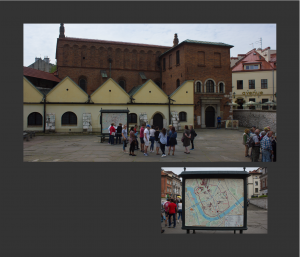
Pictured: (Above) This synagogue was originally built for men, and the yellow triangular portion of the building was the women’s section that was a later addition. (Below) Map of Kazimierz.
Our next stop was at Hopper Synagogue, a private synagogue that, according to legend, was built by a father who promised to name the synagogue after whoever married his daughter. The synagogue ended up being named after the man, so his attempt at finding a husband for his daughter was apparently unsuccessful.
Close by Hopper Synagogue was a memorial to the 65,000 Jewish citizens of Krakow killed in the Holocaust. Before WWII, approximately 68,000 Jews Poles lived in Krakow, and there were over 100 synagogues in the city. Today, only 7 remain, because most were destroyed by the Nazis. This memorial was a sobering reminder of the extent of the genocide and how Eastern European Jewry was nearly demolished by the genocide.
Anna then took us to Remuh synagogue, which was built in 1558. We had a chance to enter the building. Inside, Hasidic rabbis were praying and paying respects to a famous rabbi called Rabbi Moses, whose anniversary of death happen to fall on the day we visited the synagogue.
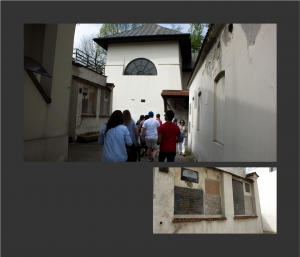
Pictured: (Above) Our group headed into the synagogue. (Below) Wall by entrance of synagogue.
The rabbis took turns approaching the banner in the front of the synagogue that covered the chest that holds the Torah scrolls, proceed to kiss the banner, and then pose for a picture in front of it. I felt fortunate to witness this demonstration of respect to the famous rabbi. After exiting the synagogue, we went to an adjacent Jewish cemetery.

Pictured: (Above) Muraled wall of synagogue, each picture depicting a story from the Hebrew Bible. (Below, right) __. (Below, left)
Outside, the Hasidic rabbis were also paying respects at the tombstones of the famous rabbis buried in the cemetery.

Pictured: (Above, left) Rocks are left on tombstones throughout the cemetery as a symbol of ___. Many of the tombstones had tin roofs to protect them from acid rain, which is a result of Krakow’s problems with pollution. (Above, right) Prayers written on scraps of paper are tucked into the crevices of Rabbi Moses’ tombstone, much like at the Wailing Wall in Jerusalem. (Below) A view of the tombstones.
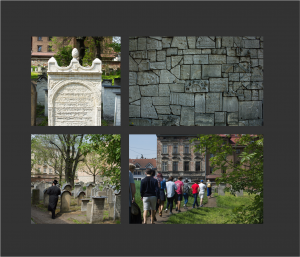
Pictured: (Above, left) One of the tombstones, with writing in Hebrew describing the person who is buried there. (Above, right) There was a wall on one side of the cemetery that was made up of tombstones that had fallen apart or crumbled. Many of these fragmented grave markers had graphics like outstretched hands, which symbolizes a blessing, or a candle, which represents women in Jewish tradition. (Below, left) A Hasidic rabbi walking among the tombstones. (Below, right) Our group being led by Anna.
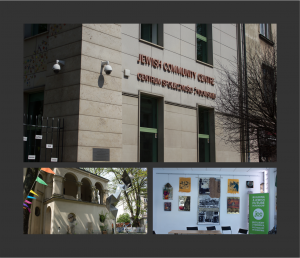
Pictured: (Above) Outside of the JCC in Krakow. (Below, right) A sculpture in the entrance. (Below, left) One of the walls in the main meeting room of the JCC.
After our tour, we had free time in the city, so we made our way to the Cloth Hall, which was a trading market established early in the city’s history. It now is home to a variety of vendors, and souvenir shops. It was a great time to explore the city a bit on our own!
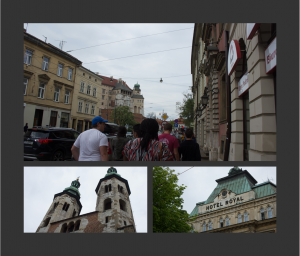
Pictured: (Above) Our group making our way towards the main square of the city. (Below, right) An old church seen on the way. (Below, left) Another building that caught my eye.
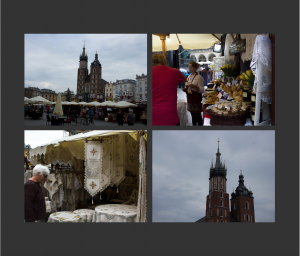
Pictured: (Above, right) The square with St. Mary’s church in the background. (Above, left) One of the many vendors. (Below, right) A woman inspecting the wares. (Below, left) Another shot of St. Mary’s.
It was a great first full day in Krakow, and learning the history of Kazimierz and Polish Jews in the city was really interesting!
